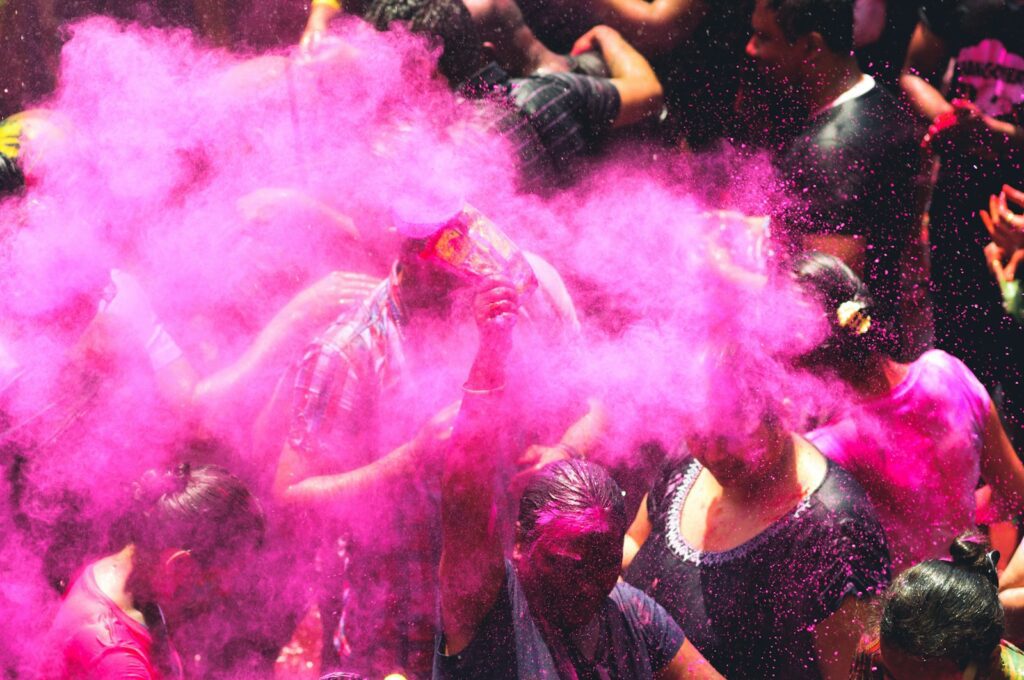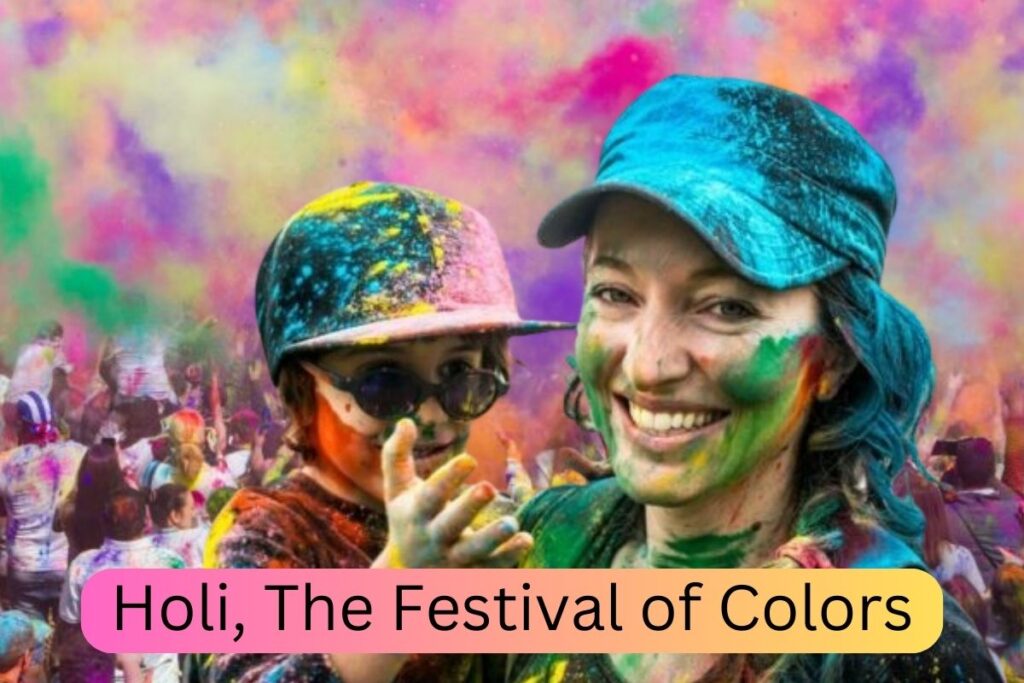Are you ready to immerse yourself in a riot of colors and joy? Holi, the vibrant festival of colors, is undoubtedly one of India’s most awaited and celebrated festivals. Each year, millions of people from all walks of life come together to partake in this jubilant occasion, marking the victory of good over evil and the arrival of spring.
Festival of Colors:
If you’re planning to experience the magic of Holi in India, you’re in for an unforgettable journey. With countless destinations across the country offering unique and exhilarating celebrations, choosing where to go can be a delightful challenge. But fear not! We’ve compiled a list of the 11 most enchanting places to celebrate Holi, ensuring that your experience is nothing short of spectacular.
1. Mathura and Vrindavan:
As the birthplace of Lord Krishna, these twin towns in Uttar Pradesh are legendary for their Holi festivities (Festival of colors) Experience the traditional ‘Lathmar Holi’ in Mathura and the ‘Phoolon wali Holi’ in Vrindavan, where flowers replace colors in a mesmerizing display of love and devotion.
2. Jaipur, Rajasthan:
Known as the Pink City, Jaipur transforms into a kaleidoscope of colors during Holi. Join the locals in the streets and witness the grandeur of the Elephant Festival, held a day before Holi, adding an extra layer of magnificence to your celebrations. Vibrant Festival of Colors.
3. Barsana, Uttar Pradesh:
Prepare yourself for an adrenaline-packed experience at Barsana’s famous ‘Lathmar Holi’. Here, women playfully beat men with sticks, reenacting a legendary battle between Lord Krishna and Radha’s companions.
4. Anandpur Sahib, Punjab:
Experience the spirit of Holi with a unique Sikh twist at Anandpur Sahib’s ‘Hola Mohalla’ festival. This martial arts extravaganza showcases awe-inspiring displays of strength, courage, and camaraderie.
5. Udaipur, Rajasthan:
Celebrate Holi like royalty amidst the majestic palaces and lakes of Udaipur. Join the extravagant processions, dance to the beats of traditional music, and indulge in mouthwatering Rajasthani delicacies.
6. Shantiniketan, West Bengal:
Explore the cultural richness of Holi at Shantiniketan, where the festival of colors is celebrated as ‘Basanta Utsav’ by the students of Visva-Bharati University, founded by Rabindranath Tagore.
7. Goa:
Add a splash of coastal charm to your Holi celebrations in Goa. Experience the ‘Shigmotsav’ festival, a blend of Holi and Carnival, featuring vibrant parades, traditional folk dances, and mesmerizing music performances. Festival of colors.
8. Delhi:
Dive into the heart of India’s capital city for an electrifying Holi experience. From the iconic ‘Holi Moo Festival’ to lively neighborhood gatherings, Delhi offers a diverse range of celebrations to suit every taste.
9. Pushkar, Rajasthan:
Immerse yourself in the spiritual ambiance of Pushkar during Holi. Witness the ‘Rang Pashi’ ceremony at the Pushkar Lake and participate in the colorful festivities that reflect the town’s mystical charm.
10. Mumbai, Maharashtra:
Experience the energetic spirit of Holi in India’s bustling metropolis, Mumbai. Join the locals in spraying colors, dancing to Bollywood beats, and savoring delicious street food delicacies. Festival of colors.
11. Kolkata, West Bengal:
Celebrate Holi with a cultural flair in the ‘City of Joy’, Kolkata. Witness the vibrant processions, indulge in traditional sweets like ‘gulab jamun’ and ‘sandesh’, and immerse yourself in the warmth of Bengali hospitality. Festival of colors.
No matter which destination you choose, celebrating Holi in India promises to be an unforgettable adventure filled with laughter, joy, and cherished memories. So pack your bags, don your brightest colors, and get ready to experience the magic of Holi like never before!

key facts, celebrating Holi, Festival of Colors in India:
Historical Significance:
- Holi’s origins can be traced back to ancient Indian mythology, particularly the legend of Prahlad and Hiranyakashipu, symbolizing the triumph of good over evil.
Date and Timing:
- Holi is celebrated on the day after the full moon in the Hindu month of Phalguna, usually falling in March on the Gregorian calendar. The festivities typically last for two days, with different regions having variations in customs and traditions.
Colors and Symbolism:
- The throwing of colored powders (gulal) and water during Holi represents the welcoming of spring and the blossoming of new beginnings. It’s a time to let go of past grievances and start afresh with love and harmony.
Regional Variations:
- Each region in India has its unique way of celebrating Holi, showcasing the country’s rich cultural diversity. From the raucous celebrations in North India to the more subdued yet colorful festivities in South India, Holi is a reflection of India’s unity in diversity.
Traditional Foods:
- Holi is incomplete without indulging in traditional sweets and savory snacks. Popular delicacies include gujiya (sweet dumplings ), thandai (a refreshing milk-based drink infused with spices), puran poli (sweet flatbread), and bhang (a cannabis-infused beverage, consumed in moderation and legal in some regions).
Safety Precautions:
- While Holi is a joyous occasion, it’s essential to take precautions to ensure a safe and enjoyable experience. This includes protecting your skin and eyes from harsh chemicals in synthetic colors by opting for natural, herbal colors or organic alternatives. Additionally, staying hydrated, wearing old clothes, and keeping valuables safe are important considerations during the celebrations.
Environmental Impact:
- In recent years, there has been growing awareness about the environmental impact of Holi, particularly regarding water wastage and pollution caused by synthetic colors. Many communities are now promoting eco-friendly celebrations by using organic colors made from natural ingredients and minimizing water usage.
Tourism Opportunities:
- Holi has become a significant tourism draw for India, attracting travelers from across the globe who seek to experience the festival’s vibrant energy and cultural richness firsthand. Many tour operators offer special Holi-themed packages, including guided tours to popular destinations and immersive cultural experiences.
Community Bonding:
- Holi is not just a festival of colors but also a time for strengthening bonds within communities and fostering a spirit of unity and togetherness. It’s an opportunity for friends, families, and neighbors to come together, burying old grievances and celebrating the joy of life.
Global Celebration:
- Beyond India, Holi is celebrated in various parts of the world, reflecting the global reach of Indian culture and traditions. Major cities with significant Indian diaspora populations, such as London, New York, and Sydney, host vibrant Holi events, bringing people of different backgrounds together in a colorful celebration of diversity and inclusivity.
These key facts help provide a broader context and deeper understanding of the significance and cultural importance of Holi in India and around the world.
Frequently Asked Questions: Celebrating Holi in India:
What is Holi, and why is it celebrated in India?
- Holi is a vibrant Hindu festival celebrated across India, marking the arrival of spring and the victory of good over evil. It’s known as the festival of colors and is celebrated with great enthusiasm and joy.
When is Holi celebrated, and how long does it last?
- Holi is typically celebrated on the day after the full moon in the Hindu month of Phalguna, which usually falls in March on the Gregorian calendar. The festivities typically last for two days, with different regions having variations in customs and traditions.
What are the main customs and rituals associated with Holi?
- The main customs of Holi include throwing colored powders (gulal) and water, singing and dancing, and indulging in festive foods and drinks. Other rituals may include lighting bonfires on the eve of Holi, known as Holika Dahan, and offering prayers to deities.
What are the best places in India to celebrate Holi?
- There are numerous enchanting destinations across India known for their unique Holi celebrations. Some popular ones include Mathura and Vrindavan in Uttar Pradesh, Jaipur in Rajasthan, Barsana in Uttar Pradesh, and Udaipur in Rajasthan, among others.
Are there any safety precautions to take during Holi celebrations?
- Yes, it’s essential to take precautions to ensure a safe and enjoyable Holi experience. This includes protecting your skin and eyes from harsh chemicals in synthetic colors, opting for natural or organic colors, staying hydrated, wearing old clothes, and keeping valuables safe.
What are some traditional foods and drinks associated with Holi?
- Traditional Holi foods include gujiya (sweet dumplings), thandai (a spiced milk drink), puran poli (sweet flatbread), and bhang (a cannabis-infused beverage, consumed in moderation and legal in some regions).
How can I participate in Holi celebrations as a tourist in India?
- Tourists can participate in Holi celebrations by joining public events and festivities, such as street parties, cultural performances, and community gatherings. Many tour operators also offer special Holi-themed packages, including guided tours to popular destinations.
What is the environmental impact of Holi, and are there eco-friendly alternatives?
- In recent years, there has been growing awareness about the environmental impact of Holi, particularly regarding water wastage and pollution caused by synthetic colors. Many communities now promote eco-friendly celebrations by using organic colors made from natural ingredients and minimizing water usage.
Can I celebrate Holi outside of India?
- Yes, Holi is celebrated in various parts of the world, especially in countries with significant Indian diaspora populations. Major cities such as London, New York, Dubai and Sydney host vibrant Holi events, bringing people of different backgrounds together in a colorful celebration of diversity and inclusivity.
What should I expect if I’m attending Holi for the first time?
- If you’re attending Holi for the first time, expect to be immersed in a riot of colors, music, and joyous celebrations. Be prepared to get drenched in colored powders and water, dance to lively beats, indulge in delicious foods, and make unforgettable memories with friends and locals alike.
In conclusion, celebrating Holi in India offers an unforgettable experience steeped in vibrant colors, cultural richness, and joyous festivities. Whether you choose to join the traditional celebrations in historical cities like Mathura and Jaipur or explore the cultural nuances of regional variations, Holi promises to be a celebration of unity, love, and new beginnings. By taking precautions for safety, embracing eco-friendly practices, and immersing yourself in the spirit of community bonding, you can ensure a memorable and meaningful Holi experience. So pack your bags, don your brightest colors, and get ready to embark on a colorful journey of discovery and celebration in the land where every shade tells a story vibrant festival of colors —India. Happy Holi!
Also, Read: India Travel: 15 Must-See Places in India: Mind-Blowing Sights Await Travelers
Visit: Lotus LifestyleTips – Your Personal Entertainer
Discover more from Lotus Travel Insightful
Subscribe to get the latest posts sent to your email.

